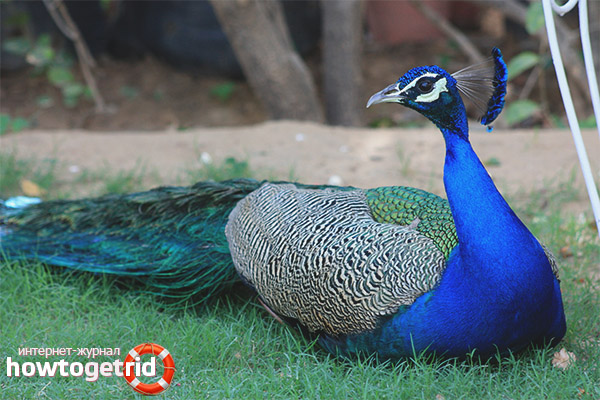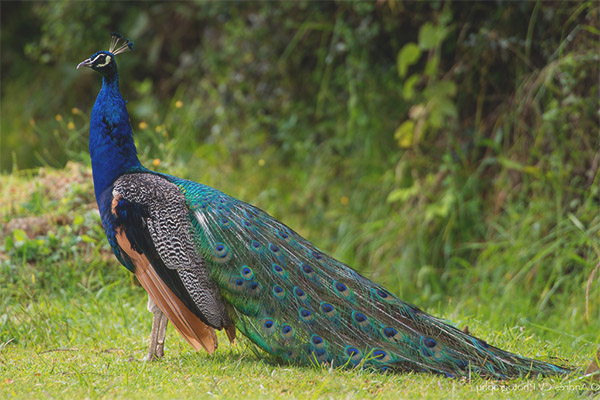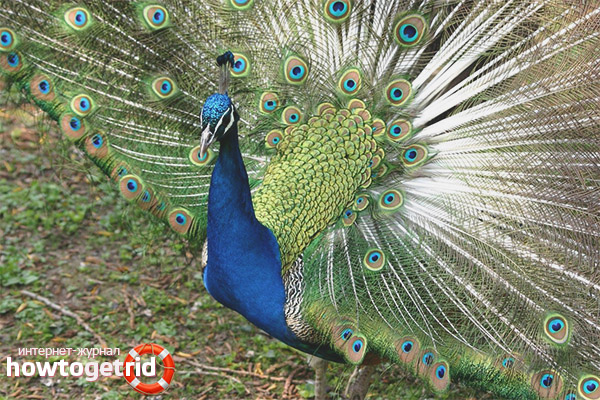The content of the article
Among other large birds, peacocks occupy a special place, the family to which they are attributed has a name - pheasant. In a close relationship with them are birds, whose tail imitates the roof structure. Unlike their relatives, pheasants are owners of a long tail, capable of surprising curvaceous. All the splendor of the peacock's tail can be assessed only in its loose state, and in this form it is very difficult to imagine that this exotic bird belongs to the order of the goose. Those who had the opportunity to contemplate such a spectacle are unlikely to have associations with domestic chickens. But the irresistible beauty of the peacock is not its only advantage.
The distinctive features of the male peacock
The total length of an adult individual reaches 1 meter 30 centimeters. That part, which is rightly considered the tail, grows up to 50 centimeters in length. But the plumage, which creates the spatial effect of the exotic tail of a bird, is in fact a fringe, whose length reaches 1 meter and 60 centimeters (in rare cases, the length of the tail of a peacock exceeds 2 meter mark). A fascinating imitation of the eye at the ends of each feather, in the tail, visually increases the real size of the tail fan.
The weight of an adult male peacock ranges between 4 to 5 kilograms.
Not only the tail feathers of this bird abound in colorful flowers, from the head to the base of the chest, the peacock male is painted in a catchy form of bright blue-nacreous shades, changing from dark blue to emerald green on his back, shaped by characteristic glossy shades. The lower part of the body of the bird is painted black, which creates an expressive contrast with the defiant colors of the neck and back.
The color of the bird's tail is also represented in several colors. In the classic version, tail feathers consist of blue, green and light brown colors.However, there are varieties of peacocks, in the color of which white predominates, such individuals can easily become an exotic decoration of any country estate for lovers of extravagant sensations.
The peacock's head is decorated with a kind of tuft, which is often called the peacock crown, crowning the head of an unusual bird. The wings of the exotic beauty are small in size, but, nevertheless, allow the bird to fly quite well.
A spicy cavalier has a pair of long and fairly strong legs to move on the ground, which allows him to move with impressive speed. Despite his holiday outfit, the peacock quite confidently can wade through the undergrowth and dig up the soil in search of food, in the model of his behavior all chicken habits can be easily seen.
With its coloring, the young male peacock strongly resembles the female with the inexpressive colors of its feathers. Only at the age of three males reach sexual maturity and for the first time clothe in their characteristic attire.
The humble image of a female peacock
The belonging of peacocks to the order of chickens is clearly expressed by the presence of sexual dimorphism in them - the female is significantly different in its appearance from the male. When looking at these birds, it seems incredible how inexpressive it looks against the background of a pompous male. The beauty of female peacocks is striking in its modesty and touching ease. They are considered to be caring mothers and are able to adorn any site with the males. The modest friend of the peacock was dubbed pava, in tune with the monotony and despondency of the color of her plumage.
Bright colors in the plumage of paws are located only on its neck, most often it is blue feathers, although sometimes they may be green. On the head of the female there is also a freakish tuft, but, in contrast to the bright blue peacock crown, the headdress of the peacocks is painted in an expressionless gray-brown color.The structure of the tail of the female is almost completely the same as that of the male, although it does not have long feathers on the upper tail, which are the main distinguishing feature of an attractive male.
Despite the fact that the outfit of the paws does not differ in many bright colors, it is not attractive, nevertheless, you will not name it. On the small head of the bird there are large expressive eyes, its smooth movements are filled with refined grace, the whole face of pava is filled with manners of importance and grandeur.
The female peacock has absolutely nothing to attract too much attention to. Its main task is to postpone laying and hatching full-fledged offspring, and it is much more convenient to sit on a nest, having a plumage suitable for disguise as the environment, than to stand out at the wrong time. It is noteworthy that the female is engaged in the construction of the nest near the peacocks.
Not so long ago, scientists established an interesting fact. It turns out that peacocks use infrasonic signals to communicate, which remain inaccessible to human hearing.
Characteristics of the behavioral manners and lifestyle of peacocks
Peacocks spend most of their lives moving on their feet, although they generally fly well, but these birds cannot climb high into the sky or fly long distances. And on his feet the peacock feels very confident, despite his long tail, he is quite easily able to overcome various obstacles, such as thick tangles of tall grasses and insuperable seemingly overgrown shrubs.
The majestic view of the peacock in fact turns out to be very deceptive, considering that it belongs to a fearful and cautious animal, ready to take flight at the slightest danger. The voice of the peacock, which he is in no hurry to brag about, is distinguished by its sharpness and piercingness. Interestingly, peacocks use loud beeps not only at the moment of danger, but also in foreshadowing the rain, like many other birds, for example, crows. The rest of the time, even at the time of the marriage preludes, the peacock maintains a proud silence.
Peacocks do not live in pairs in the manner of many other birds, the peacock's harem has from four to six females. Night time peacocks spend, sitting on a high tree, drunk before this plenty.Not infrequently before bedtime, they like to organize noisy concerts. The peacock always begins its morning with a visit to a watering place and only after that the search for edibles begins.
When the peacock chicks grow stronger and grow up sufficiently, the birds gather in flocks of up to 60 individuals, during this period they molt and the males lose their sparkling tail.
Life expectancy of a peacock in nature rarely exceeds 15 years, and in captivity, some individuals can reach 25 years of age.
What is the menu of the majestic bird

Peacocks prefer to eat exclusively on the ground. The basis of the bird's diet includes the seeds of various plants, young green shoots and leaves, all kinds of fruits and berries. But to consider them vegetarians is a mistake, because with great pleasure they are ready to eat both invertebrate animals and small vertebrates, such as: various lizards, toads, small rodents and even snakes.
It is noteworthy that in the villages of India, people have long kept peacocks just for the extermination of a large population of snakes.The most interesting thing is that the birds do not disdain even the most poisonous representatives of reptiles.
Reproduction and breeding of offspring
Peacocks are characteristic representatives of polygamous relationships, the harem of an adult male, as a rule, has up to 6 females. The breeding season of these birds begins in April and is in the active phase until the end of September. Before the onset of the nesting period, peacocks arrange enchanting mating games. Having gathered in the open area, each male, defiantly dismissing its tail, skillfully performs the honed movements of the mating dance. Performing unhurried turns, he effectively presents his outfit in various angles.
Basically, pawns make their nests on the ground, trying to hide from the eyes, using any shelter. But in rare cases, their nests can be found on trees and even on roofs. Most often this happens because they do not disdain to occupy the empty nests of other birds.
Only a caring female is engaged in incubation of eggs in peacocks, the incubation period of her offspring lasts 28 days. The nestlings of these representatives of the Curonidae order are directly related to the category of brood birds. Only when they come into the world do they automatically follow their mother as enchanted.
Video: Javanese Peacock












To send